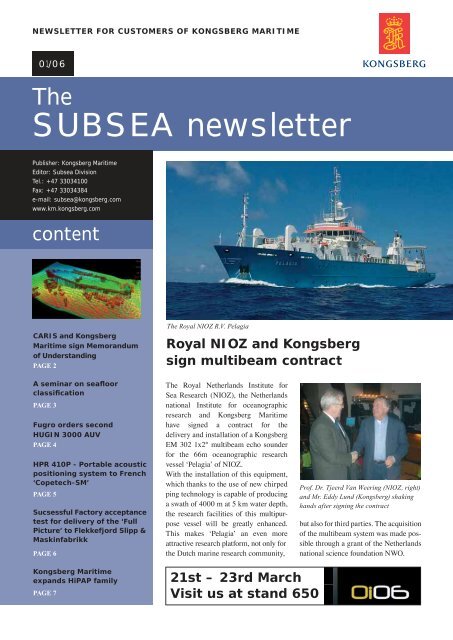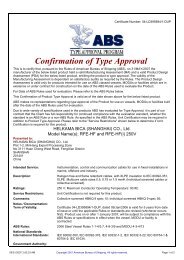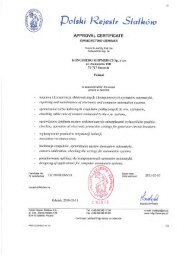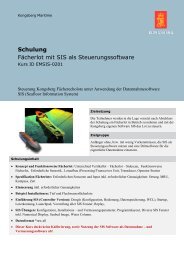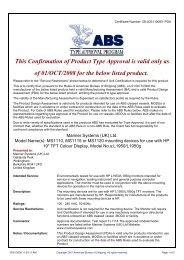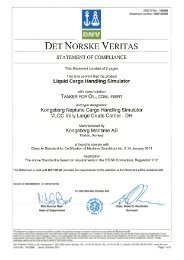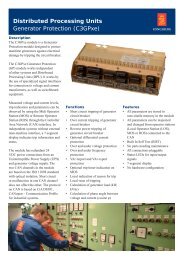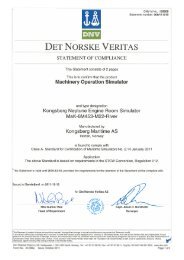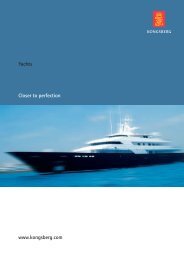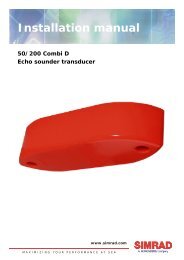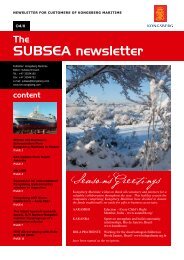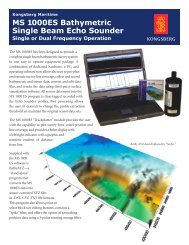March 2006 - Kongsberg Maritime
March 2006 - Kongsberg Maritime
March 2006 - Kongsberg Maritime
Create successful ePaper yourself
Turn your PDF publications into a flip-book with our unique Google optimized e-Paper software.
NEWSLETTER FOR CUSTOMERS OF KONGSBERG MARITIME<br />
01/06<br />
The<br />
SUBSEA newsletter<br />
Publisher: <strong>Kongsberg</strong> <strong>Maritime</strong><br />
Editor: Subsea Division<br />
Tel.: +47 33034100<br />
Fax: +47 33034384<br />
e-mail: subsea@kongsberg.com<br />
www.km.kongsberg.com<br />
content<br />
CARIS and <strong>Kongsberg</strong><br />
<strong>Maritime</strong> sign Memorandum<br />
of Understanding<br />
PAGE 2<br />
The Royal NIOZ R.V. Pelagia<br />
Royal NIOZ and <strong>Kongsberg</strong><br />
sign multibeam contract<br />
A seminar on seafloor<br />
classification<br />
PAGE 3<br />
Fugro orders second<br />
HUGIN 3000 AUV<br />
PAGE 4<br />
HPR 410P - Portable acoustic<br />
positioning system to French<br />
‘Copetech-SM’<br />
PAGE 5<br />
Sucsessful Factory acceptance<br />
test for delivery of the ‘Full<br />
Picture’ to Flekkefjord Slipp &<br />
Maskinfabrikk<br />
PAGE 6<br />
The Royal Netherlands Institute for<br />
Sea Research (NIOZ), the Netherlands<br />
national Institute for oceanographic<br />
research and <strong>Kongsberg</strong> <strong>Maritime</strong><br />
have signed a contract for the<br />
delivery and installation of a <strong>Kongsberg</strong><br />
EM 302 1x2° multibeam echo sounder<br />
for the 66m oceanographic research<br />
vessel ʻPelagiaʼ of NIOZ.<br />
With the installation of this equipment,<br />
which thanks to the use of new chirped<br />
ping technology is capable of producing<br />
a swath of 4000 m at 5 km water depth,<br />
the research facilities of this multipurpose<br />
vessel will be greatly enhanced.<br />
This makes ʻPelagiaʼ an even more<br />
attractive research platform, not only for<br />
the Dutch marine research community,<br />
Prof. Dr. Tjeerd Van Weering (NIOZ, right)<br />
and Mr. Eddy Lund (<strong>Kongsberg</strong>) shaking<br />
hands after signing the contract<br />
but also for third parties. The acquisition<br />
of the multibeam system was made possible<br />
through a grant of the Netherlands<br />
national science foundation NWO.<br />
<strong>Kongsberg</strong> <strong>Maritime</strong><br />
expands HiPAP family<br />
PAGE 7<br />
21st – 23rd <strong>March</strong><br />
Visit us at stand 650
THE SUBSEA NEWSLETTER PAGE 2<br />
MARCH <strong>2006</strong><br />
CARIS and <strong>Kongsberg</strong> <strong>Maritime</strong> sign Memorandum<br />
of Understanding<br />
CARIS, Canada and <strong>Kongsberg</strong> <strong>Maritime</strong><br />
have signed a memorandum of understanding<br />
to collaborate and deliver<br />
CARIS HIPS/SIPS multibeam processing<br />
software to existing and potential<br />
KONGSBERG clients.<br />
Single off-the-shelf<br />
software product<br />
CARIS HIPS/SIPS represents a single<br />
off-the-shelf software product that<br />
embodies all of the very latest statisticalbased<br />
data cleaning and processing<br />
methodologies currently reshaping the<br />
ocean mapping industry in one single<br />
package. The addition of HIPS/SIPS<br />
to KONGSBERGʼs existing multibeam<br />
processing products appeals to a greater<br />
diversity and variety of end-user needs,<br />
thus strengthening market position.<br />
Ongoing cooperation<br />
As part of this agreement, CARIS will<br />
provide ongoing marketing, sales and<br />
training support for the HIPS/SIPS<br />
software to KONGSBERG engineers<br />
and sales specialists. Further, the two<br />
parties have committed to working<br />
cooperatively on an ongoing basis, to<br />
offer migration from Neptune users to<br />
HIPS/SIPS and to ensure that the technical<br />
needs of KONGSBERG clients<br />
are being met in future planning of the<br />
HIPS/SIPS software.<br />
Independent of data formats<br />
“We are pleased to work with <strong>Kongsberg</strong>,<br />
enabling more multibeam processing<br />
options for their clients,” said Derrick<br />
Peyton, CARIS Marketing and Sales<br />
Manager. “As companies face issues of<br />
large bathymetric data sets, interoperability<br />
and distribution, CARIS multibeam<br />
processing and data management<br />
software supports KONGSBERG clients<br />
with their data cleaning and processing<br />
needs regardless of the data format and<br />
workflow.”<br />
Quality multibeam processing tool<br />
“It is our objective through this<br />
collaboration with CARIS to ensure<br />
<strong>Kongsberg</strong> customer satisfaction by<br />
providing a quality multibeam processing<br />
tool that is well supported to existing<br />
and potential clients. However, our well<br />
known and well tested NEPTUNE post<br />
processing software will still be available<br />
as a choice for the users,” says Freddy<br />
Pøhner, Vice President Sales and Marketing<br />
for <strong>Kongsberg</strong> <strong>Maritime</strong>-Subsea.<br />
About HIPS and SIPS<br />
The HIPS and SIPS product is a comprehensive<br />
bathymetric data cleaning<br />
and validation tool integrated with powerful<br />
vector product creation. HIPS and<br />
SIPS can take the raw sounding data<br />
from ship to chart. Supporting over 40<br />
industry standard sonar data formats,<br />
HIPS and SIPS can easily integrate into<br />
any workflow. Proven automated data<br />
cleaning filters and algorithms assist in<br />
todayʼs high data volume environments.<br />
This, coupled with the ability to easily<br />
produce vector products such as contours<br />
and selected soundings, makes the<br />
software a powerful production tool.<br />
Croon Bakker Combination and <strong>Kongsberg</strong> <strong>Maritime</strong><br />
sign multibeam contracts<br />
Croon Bakker Combination, Netherlands,<br />
has been awarded the contract<br />
for the supply and integration of a<br />
number of systems for the two new<br />
pipe laying vessels ordered at<br />
Merwede shipyard by Subsea 7. The<br />
two vessels will be equipped with an<br />
EM 1002 multibeam echosounder – in<br />
addition to DP, HiPAPs and other<br />
sensors from <strong>Kongsberg</strong> <strong>Maritime</strong>.
THE SUBSEA NEWSLETTER PAGE 3<br />
MARCH <strong>2006</strong><br />
A seminar on seafloor classification<br />
December 1 and 2 2005, <strong>Kongsberg</strong><br />
<strong>Maritime</strong> invited some of the users<br />
of Neptune (later named Neptune-B),<br />
Triton (later named Neptune-C) and<br />
Poseidon (later named Neptune-S) to<br />
Horten for a seminar on seafloor<br />
classification.<br />
The seminar gathered participants from<br />
<strong>Kongsberg</strong> <strong>Maritime</strong>, several customers<br />
using our products, scientists and developers<br />
from research institutions.<br />
The first thing to discuss was how to<br />
use multibeam echosounders as a tool<br />
for seafloor classification. Kjell Nilsen<br />
from <strong>Kongsberg</strong> <strong>Maritime</strong> gave an<br />
overview of the acoustic principles of<br />
multibeam echosounders and the ongoing<br />
development in Horten. Terje<br />
Pedersen (KM) presented the state<br />
of Neptune-B, -C and -S and the road<br />
ahead for the product was discussed.<br />
The new classification tool for Kongeberg<br />
single beam echosounders was demonstrated<br />
by T. T. Lied (KM). This tool,<br />
SeaBec, can take advantage of serveral<br />
frequencies to classify the seafloor. The<br />
results are available immediately in<br />
the geographical display and there are<br />
several options to control the operation<br />
of SeaBec.<br />
The seminar also contained papers from<br />
the participants. Professor J. M. Hovem<br />
presented a paper on how to use scattering<br />
theory in seafloor classification,<br />
M. A. Larsen presented his method for<br />
seafloor classification, R. Riethmuller<br />
presented results from seafloor classification<br />
using EM 3002 and ways to<br />
improve the system. M. Roche and K.<br />
Degrendele presented results from using<br />
Neptune-C and suggested tools to<br />
help the users make better use of the<br />
output from Neptune-C. T. Thorsnes<br />
presented a paper on how to use seafloor<br />
classification in the MAREANO<br />
project and needs for improvements in<br />
hardware and software. D. Simons and<br />
T. Driesenaar presented a seafloor classification<br />
system developed by TNO.<br />
Valuable contacts were made during<br />
the following discussions. The users of<br />
Neptune have over the years gathered<br />
vast experience in the use of seafloor<br />
classification, and the joint cooperation<br />
between the users, and between the<br />
users and scientists, will help the<br />
development of seafloor classification<br />
tools in the future.<br />
As a result of this seminar, new<br />
versions of Neptune-B, -C and -S are<br />
made available that we hope will help<br />
the users to make better use of the<br />
classification done in Neptune-C.<br />
Pipe-surveys in the North Sea<br />
Over the past year, the EM 3002 has<br />
been run on several pipe-surveys in<br />
the North Sea, by Stolt Offshore, now<br />
Acergy.<br />
The performance of the system has<br />
been documented and the EM 3002<br />
has been verified to be an important<br />
tool for inspecting gas and oil-pipes.<br />
The system has also been tested<br />
by Geoconsult on a new coated 8”<br />
pipe with good results. The system<br />
was tracking and displaying the<br />
pipe without any problems when the<br />
pipe was on support legs, and on the<br />
seabed without support legs.
THE SUBSEA NEWSLETTER PAGE 4<br />
MARCH <strong>2006</strong><br />
Fugro orders second HUGIN 3000 AUV<br />
commissioning of the system. This<br />
team draws from key staff involved in<br />
previous AUV, ROV and geophysical<br />
survey operations and has proven to<br />
be an exceptional combination. The<br />
integrated, multi-disciplinary approach<br />
ensures maximum efficiency and effectiveness<br />
based on the broadest range of<br />
skills, knowledge and experience.<br />
HUGIN AUVs have, since their market<br />
introduction in 1997, successfully been<br />
used for civilian and military applications.<br />
More than 60.000 km of accumulated survey<br />
world wide for the Offshore Oil & Gas<br />
industry is achieved with the HUGIN 3000<br />
class AUVs, in the range from shallow and<br />
down to 3000 meter water depth.<br />
Following the successful deployment of<br />
Fugroʼs Echo Surveyor HUGIN 3000<br />
Autonomous Underwater Vehicle (AUV)<br />
in 2005, Fugro NV, in the Netherlands,<br />
has placed an order with <strong>Kongsberg</strong><br />
<strong>Maritime</strong> for the purchase of a second<br />
deep water HUGIN 3000 AUV.<br />
The new build HUGIN 3000 will<br />
be equipped to the same standard as<br />
Echo Surveyor. It will also incorporate<br />
the modifications that were already<br />
made to the Echo Surveyor to enhance<br />
operational efficiency, improve safety<br />
and environmental performance to meet<br />
Fugroʼs requirements.<br />
The new build HUGIN 3000 will be<br />
delivered and tested during winter <strong>2006</strong><br />
and will be ready for operation before<br />
the end of the year. Fugroʼs dedicated<br />
specialist AUV team will again work<br />
with <strong>Kongsberg</strong> <strong>Maritime</strong> over the<br />
next few months during the build and<br />
Due to its unique semi fuel cell battery<br />
technology the vehicles are repeatedly<br />
running survey missions with up to 60<br />
hours endurance with all payload<br />
sensors in operation simultaneously.<br />
Such sensors comprise Side Scan Sonar,<br />
Sub Bottom Penetration Sonar, Multi<br />
Beam Echosounder, and sensors for<br />
measuring conductivity, temperature<br />
and depth. The superior vehicle<br />
control and navigation systems allow<br />
the vehicle to be safely operated in<br />
rough terrain and with high position<br />
accuracy in very deep water.<br />
EA 400SP Splash proof<br />
Early in 2005 we introduced an improved<br />
EA 400 portable and splash<br />
proof echo sounder. Recently we have<br />
also released new software for the EA<br />
400/SP/600, providing new features<br />
and possibilities.<br />
The EA 400SP is a dual frequency<br />
echo sounder operated with a rugged<br />
notebook PC (Tablet PC Edition).<br />
38/200kHz frequency is the standard<br />
configuration - vertical or side looking<br />
transducer(s), powered with 12VDC.<br />
It is easy to commission and therefore<br />
perfect for surveying in shallow water<br />
depth in small and open boats. The new<br />
EA 400 and EA 600 software, has been<br />
improved with several new features,<br />
such as side enhanced looking imaging,<br />
replay function and new data formats.<br />
The EA has for a long time featured the<br />
possibility for side looking imaging, a<br />
feature already popular with users. The<br />
new side looking software has been improved<br />
by scrolling the image vertically<br />
and exporting of georef data on the network<br />
(position and across distance to<br />
an object). For correct across distance,<br />
a vertical transducer must be installed.<br />
Other enhancements includes:<br />
• New functionality in the replay<br />
dialog box (slider and storing of<br />
existing raw file)<br />
• XYZ values in ascii format<br />
(interpolated depth) stored to HD<br />
• Remote control of start and stop<br />
logging/ pinging and history file<br />
• Extended function to detect second<br />
hard bottom with the lowest frequency<br />
in the system. Needed frequencies<br />
e.g. 38/200kHz.
THE SUBSEA NEWSLETTER PAGE 5<br />
MARCH <strong>2006</strong><br />
The Hydrographic Institute - Split and <strong>Kongsberg</strong><br />
<strong>Maritime</strong> sign multibeam contract in January<br />
HPR 410P - Portable acoustic positioning system to<br />
French ‘Copetech-SM’<br />
‘Copetech-SM’ is a French company<br />
specializing in survey missions and<br />
submarine inspection by ROV to<br />
1000m depth. Their brand new <strong>Kongsberg</strong><br />
HPR 410P is now onboard their<br />
new Deep-Sea Survey Unit 1000.<br />
This autonomous unit was especially<br />
designed for deep-sea ROV diving. Its<br />
principal missions are assistance to oil<br />
& gas submarine works. The unit is<br />
easily movable on any floating support<br />
vessel which can accept a 20 feet long<br />
container. ‘Coptech-SM’ is present<br />
in France, French territories and<br />
The Hydrographic Institute of the Republic<br />
of Croatia (www.hhi.hr) and<br />
<strong>Kongsberg</strong> <strong>Maritime</strong> have signed a contract<br />
for the delivery and installation of<br />
an EM 3002D multibeam echosounder<br />
for the 22m long survey vessel RV<br />
ʻHIDRAʼ.<br />
The vessel carries out multidisciplinary<br />
ocean surveys mostly to ensure safe<br />
navigation.<br />
“With the new Multibeam system the<br />
Institute is well prepared to serve different<br />
environments looking for detailed<br />
information about the seafloor,”<br />
says Dr.sc. Zvonko Grzetic, director of<br />
the Institute.<br />
especially in the French Antillas with a<br />
dedicated office for South America.<br />
For more information:<br />
www.copetechsm.fr<br />
HUGIN record-breaking mission<br />
Tuesday evening, 27 December 2005,<br />
HUGIN was recovered after a recordbreaking<br />
mission.<br />
Mission 91 lasted for more than 66<br />
hours, with Hugin covering a distance<br />
of 430 km. This was performed with<br />
water depths in the range of 400 to<br />
1050 meters, in very challenging<br />
terrain and partially on flat seabed.<br />
The mission plan included nearly 500<br />
waypoints, where approx. 50 waypoints<br />
were changed via acoustic link<br />
during the execution of the mission.<br />
Payload logged was Simrad EM 2000<br />
150° multi-beam echo-sounder, Edgetech<br />
FS AU SSS/SBP, dig quartz<br />
2000m depth sensor and FSI<br />
2”MCTD sensor.
THE SUBSEA NEWSLETTER PAGE 6<br />
MARCH <strong>2006</strong><br />
Sucsessful Factory acceptance test for delivery of the<br />
‘Full Picture’ to Flekkefjord Slipp & Maskinfabrikk<br />
Britainʼs leading environmental<br />
research organization has commissioned<br />
Flekkefjord Slipp & Maskinfabrikk<br />
to build a state-of-the art scientific<br />
research ship to replace the RRS Charles<br />
Darwin. The RRS Charles Darwin has<br />
been supporting researchers since 1985<br />
and is now coming to the end of its<br />
working life.<br />
The 5,000 tonne ship, the James Cook,<br />
will operate worldwide - from the tropics<br />
to the edge of the ice sheets - enabling<br />
cutting edge scientific research.<br />
The shipʼs design will enable it to work<br />
in higher sea-states than the Research<br />
Councilʼs other dedicated research vessels.<br />
It will be more manoeuvrable, have<br />
more scientific berths, and better technical<br />
facilities.<br />
Chief Executive of the Natural Environment<br />
Research Council, Professor John<br />
Lawton explains why this new ship is<br />
essential. “We need year-round access<br />
to dedicated research ships for the foreseeable<br />
future. The James Cook will<br />
help answer the biggest environmental<br />
questions facing us in the next century:<br />
in climate change, evolution, ocean circulation<br />
and biodiversity. The research it undertakes<br />
will have an impact on all of us.”<br />
The ship will be operated by NERCʼs<br />
Research Ship Unit based at Southampton<br />
Oceanography Centre. Chairman of<br />
the procurement board for the new ship,<br />
and director of the centre is Professor<br />
Howard Roe.<br />
The ship will be completed summer<br />
<strong>2006</strong> and the following equipment<br />
FROM LEFT: Edward Cooper, Project Liaison Offi cer NERC, Rune Olsen, Over all project<br />
manager, Tore Nilsson, test engineer, Raymond Halvorsen, technician test , Sigbjørn Sirnes,<br />
Project Manager Flekkefjor Slipp & Maskinfabrikk<br />
was tested during FAT in Horten 2-3<br />
<strong>March</strong>:<br />
Multibeam echosounders:<br />
• EM 120 1X1 degree system<br />
• EM 710 2X2 degree system<br />
Sub bottom profiler:<br />
• SBP 3X3 degree system, using<br />
EM 120 RX transducer and electron<br />
ics for receive of signals.<br />
Single beam Hydrography<br />
echosounder:<br />
• EA 600 12Khz<br />
Split beam Fishery Recearch<br />
echo sounder:<br />
• EK60 18,38,70,120 and 200 Khz<br />
Synchronization unit:<br />
• SSU for synchronization of EM 120,<br />
SBP, EM 710, EA 600, EK60,<br />
ADCP75and ADCP150<br />
Marine Data Management system:<br />
• MDM 400<br />
The following equipment was tested<br />
during FAT in <strong>Kongsberg</strong> 8-9 <strong>March</strong>:<br />
Alarm and monitoring system:<br />
• SVC400 with approx. 1000 I/Oʼs<br />
DP and joystick system:<br />
• SDP 11<br />
• cJoy<br />
In addition, <strong>Kongsberg</strong> <strong>Maritime</strong> has<br />
delivered a complete navigation package<br />
with bridge consoles.<br />
This is close to what we call “The Full<br />
Picture”<br />
KOG - wins MNOK 15 contract with the US Navy<br />
<strong>Kongsberg</strong> <strong>Maritime</strong>ʼs US subsidiary,<br />
<strong>Kongsberg</strong> Underwater Technology<br />
Inc., has signed a MNOK 15 contract<br />
to provide several integrated sonar and<br />
echo sounder systems to the US Navy.<br />
The contract also includes four years of<br />
options with a potential total value of<br />
appr. MNOK 190.<br />
These systems are designed for permanent<br />
installation aboard the six T-AGS<br />
60 class survey vessels operated by<br />
the US Naval Oceanographic Office<br />
(NAVOCEANO).<br />
The contract covers a five-year period,<br />
meaning that if all options are exercised,<br />
it will continue until February<br />
2011. The contract encompasses design,<br />
manufacture, testing, integration,<br />
installation and overall support for the<br />
new systems.
THE SUBSEA NEWSLETTER PAGE 7<br />
MARCH <strong>2006</strong><br />
<strong>Kongsberg</strong> <strong>Maritime</strong> expands HiPAP Family<br />
<strong>Kongsberg</strong> <strong>Maritime</strong> will unveil two<br />
new members of its highly regarded<br />
HiPAP® underwater positioning system<br />
family at Oi06.<br />
HiPAP Goes Portable<br />
HiPAP 350P is the only automatic beam<br />
steering portable transducer on the market<br />
and is an ideal tool for the ʻVessel<br />
of Opportunityʼ due to its ease of transport<br />
and set-up. With its new, unique<br />
and compact transducer accompanied<br />
by a built-in accurate Motion Reference<br />
Unit, HiPAP 350P can be used on almost<br />
any vessel at short notice.<br />
The transducer is designed to be mounted<br />
on a shaft to be installed over-theside<br />
or through a moon-pool of a vessel.<br />
With its 345 mm diameter transducer<br />
head, it can also penetrate all existing<br />
12 inch / 350 mm gate valves.<br />
The system uses unique narrow pointing<br />
beam technology, to minimise the<br />
effect of noise from noise sources such<br />
as propellers and thrusters. The 46-element<br />
transducer creates a narrow beam<br />
of +/- 7,5 degrees, which can be pointed<br />
towards the transponder(s) in any direction<br />
within a 120-degree cone below the<br />
vessel.<br />
The operational area can easily be extended<br />
or changed by simply mounting<br />
the transducer on a tilted bracket,<br />
facing the sector to the wanted area.<br />
There is no need for extra calibration,<br />
or mechanical fine adjustments, as the<br />
internal Motion Reference Unit will automatically<br />
compensate for the tilt.<br />
New Low Frequency HiPAP<br />
HiPAP 100 is the new and Low Frequency<br />
member of the HiPAP® system<br />
family. With high accuracy, good<br />
repeatability and high reliability, the<br />
HiPAP 100 system is the multi-purpose<br />
acoustic positioning system for ultra<br />
deep water operations.<br />
The HIPAP 100 system is supplied<br />
as an ʻultra deep waterʼ version using<br />
transponders for high water pressure.<br />
Transponders with depth rating down to<br />
6500 m are available. The HIPAP 100<br />
is well proven, and it provides the simplest<br />
way to position ROVs and other<br />
objects in very deep water.<br />
The beam forming, signal detection and<br />
digital signal processing are based on<br />
the same principles as the other well<br />
proven HiPAP family members. The elements<br />
are all computer-controlled and<br />
the system will dynamically control<br />
a narrow listening beam towards the<br />
transponder(s), minimising the noise<br />
influence from the vesselʼs thrusters<br />
and propellers.<br />
About HiPAP<br />
HiPAP was first developed with the focus<br />
of using the Super Short Base Line<br />
(SSBL) principle, as the market requirement<br />
was to try to avoid the Long Base<br />
Line (LBL) principle in deep water accurate<br />
seabed survey applications.<br />
The main advantage of the SSBL principle<br />
is that it only requires installation of<br />
one vessel-mounted transducer and one<br />
subsea transponder. The unique transducer<br />
technology along with advanced<br />
digital signal processing of HiPAP has<br />
been proven to obtain optimal position<br />
accuracy. The HiPAP series of transducers<br />
features many more elements<br />
than any of its competitors. This provides<br />
increased acoustical redundancy,<br />
mathematical redundancy and improvement<br />
of the Signal to Noise level.<br />
All HiPAP systems can now also install<br />
a Long Base Line functionality providing<br />
the operator flexibility when this is<br />
required. All HiPAP systems use the<br />
same Acoustic Positioning Operating<br />
System (APOS) and Man Machine interface.<br />
The APOS consists of a Color<br />
Display, an Acoustic Positioning Computer<br />
(APC), Keyboard and tracker-ball.<br />
Delivery of EM 3002<br />
Bakker Sliedrecht Electro Industrie B.V.<br />
and <strong>Kongsberg</strong> <strong>Maritime</strong> signed a contract<br />
for the delivery of EM 3002 to two<br />
new vessels to be built for the Swedish<br />
coastguard. The two multibeam echosounders<br />
are a small part of a total package to be<br />
supplied by <strong>Kongsberg</strong> <strong>Maritime</strong>.


